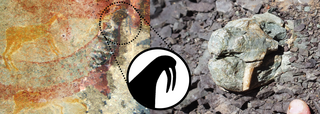The Horned Serpent panel, in the Koesberg mountains, gorgeously depicts elements of the San culture and was partly figured and described by Stow and Bleek in plates 36–39. The rock art was made at an unknown date by the “Bushmen of the East” , now referred to as the /Xam speaking San .
One of these elements is an unidentified animal that bears two enlarged tusks, making it superficially look like a walrus.
This walrus-like figure has been the object of much speculation regarding its identity, because no representative of the Odobenidae lives or has ever lived nearby sub-saharan African coasts.
The question of the identity of this animal has been dismissed because it is seemingly a rain-animal from the San “spirit-realm”, which is spiritual by essence and does not have to be realistic ; however, this does not address the question of what inspired this figure in the first place.
Conclusion
The ethnographic, archaeological, and palaeontological evidence are consistent with the hypothesis that the Horned Serpent panel could possibly depict a dicynodont.
This is supported by i) the downward orientation of the tusks on the La Belle France tusked animal (Fig 3A and 3B), which does not match that of any modern African animals, but does match the tusks of dicynodonts (Figs 1B and 3C), ii) the abundance of dicynodont fossils in the area (Fig 5), and iii) the local San belief into a long extinct, large animal .
This would imply that the San may have i) discovered dicynodont fossils, ii) interpreted them as long-extinct species, iii) made a painting of one of them at La Belle France, and iv) integrated them into their worldview.
If so, this would evidence that Later Stone Age people were aware of dicynodont fossils at least a decade before their formal scientific description by western scientists , and made the first known reconstruction of one of them.
Even if one considers that the Horned Serpent panel has a purely spiritual meaning, it does not invalidate the hypothesis that the tusked animal itself may have been imagined based on a dicynodont fossil.
The spiritual and palaeontological interpretation of this painting are not mutually exclusive. Helm et al. were the first to propose that some of the strangest animals in the San rock art may be interpreted as depictions of Permian reptiles, and the current contribution supports that perhaps there may be more dicynodont depictions to be found among some of the paintings and petroglyphs preserved in the Karoo.


